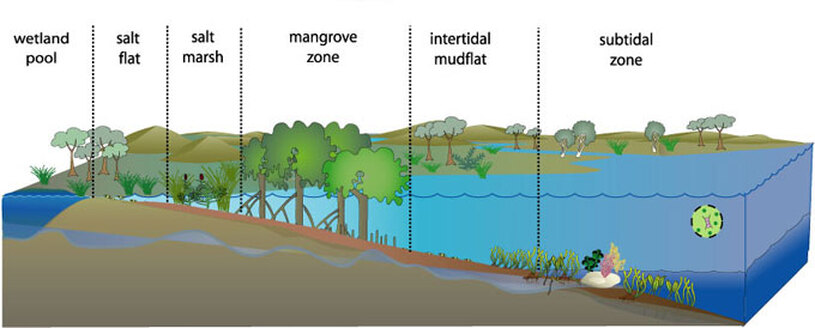What are estuaries?
 ozcoasts.org.au ozcoasts.org.au
Estuaries are quite simply areas where rivers meet the sea. As the interface between the terrestrial and marine environments, estuaries are incredibly dynamic ecosystems that are ecologically, recreationally, and commercially valuable. While estuaries come in many shapes and sizes, from shallow lagoon systems to deep fjords, all are characterized by salinity gradients ranging from the river’s fresh water, becoming increasingly salty until reaching the ocean. River flow and tidal energy control this gradient and cause estuaries to experience changing water levels over time. The dynamic salinity and tidal ranges estuaries experience create distinct ecosystems within each estuary including fringing ecosystems such as salt marshes and mangroves which are flooded only at high tide, intertidal flats and rocky ecosystems, shallow subtidal systems exposed only on large tides, and deeper subtidal areas that are always submerged.
These estuarine sub-systems transition over relatively small spatial scales compared to other ecosystems, creating dynamic habitats and environments as well as large flows of energy and complex nutrient cycles. High rates of primary productivity both on the bottom (seagrass, kelp, and sediments) and in the water column (phytoplankton) within estuaries fuel some of the world’s most productive and valuable fisheries. Intertidal areas such as mangroves, salt marshes, and tidal flats serve as important nursery habitats for these fisheries, as well as feeding grounds for shore and migratory birds, and help protect against storm surges and sea level rise. Many inter and subtidal zones of estuaries also fix CO2, trapping that carbon (known as blue carbon) and sequestering it away from the atmosphere for long periods of time. Estuaries also serve as important filters of pollutants including heavy metals, nitrogen, and microplastics; trapping or removing many before they can reach the open ocean. All of these important processes are examples of ecosystem services that estuaries provide and that we, as humans, rely on for air & water quality, food, recreation, and survival. While we take many of these crucial services for granted, most of them are threatened by various human activities. In fact, because we so often settle along coasts, estuarine systems are some of the most heavily impacted and threatened natural ecosystems in the world. It is therefore vital that we understand the importance of estuaries, how they function, and how we are changing them, so that their many services are not lost. |
Summary |